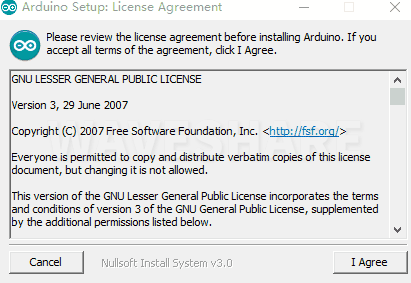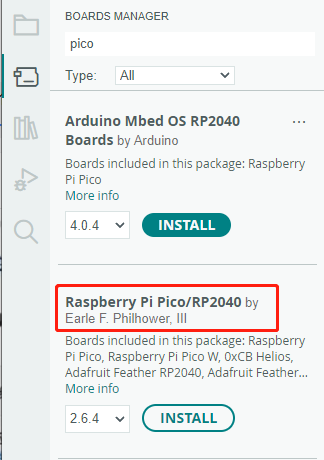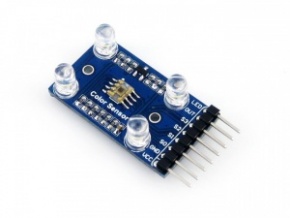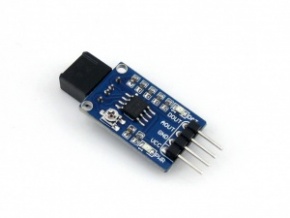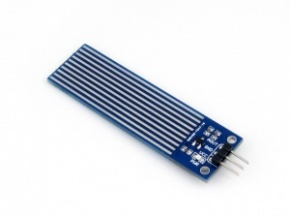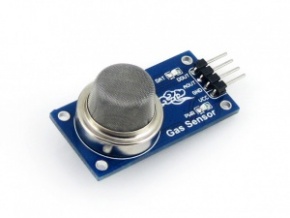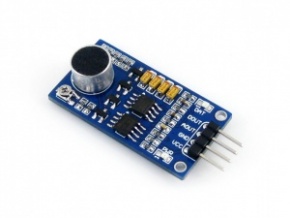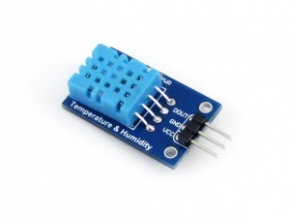Rotation Sensor
| ||
Overview
Specifications
| Item | Parameter |
| Operating voltage | 3.0V-5.3V |
| Pulses per lap | 20 |
| Dimensions | 32.0mm*15.0mm |
| Mounting holes size | 2.0mm |
Principle: The incremental encoder is a rotary sensor that converts rotary displacement into a series of digital pulse signals. By rotation, the number of output pulses can be counted in both positive and negative directions of rotation. Unlike a potentiometer, there is no limit to the number of rotations that can be counted. Unlike a potentiometer, there is no limit to the number of rotations that can be counted.
Pinouts
In the case of working with a MCU:
- VCC ↔ 3.0V ~ 5.3V
- GND ↔ power supply ground
- SW ↔ MCU.IO (encoder button status)
- SIB ↔ MCU.IO (output status)
- SIA ↔ MCU.IO (output status)
Wave of Encoder
Connect the SIA, SIB, and SW port to CH5, CH6, and CH7 of a logic analyzer.
Rotate the sensor and check the wave.
Pico Quick Start
Download Firmware
- MicroPython Firmware Download
- C_Blink Firmware Download
Video Tutorial
- Pico Tutorial I - Basic Introduction
- Pico Tutorial II - GPIO
- Pico Tutorial III - PWM
- Pico Tutorial IV - ADC
- Pico Tutorial V - UART
- Pico Tutorial VI - To be continued...
MicroPython Series
- 【MicroPython】 machine.Pin Function
- 【MicroPython】 machine.PWM Function
- 【MicroPython】 machine.ADC Function
- 【MicroPython】 machine.UART Function
- 【MicroPython】 machine.I2C Function
- 【MicroPython】 machine.SPI Function
- 【MicroPython】 rp2.StateMachine
C/C++ Series
Arduino IDE Series
Install Arduino IDE
-
Download the Arduino IDE installation package from Arduino website.
-
Just click on "JUST DOWNLOAD".
-
Click to install after downloading.
-
Note: You will be prompted to install the driver during the installation process, we can click Install.
Install Arduino-Pico Core on Arduino IDE
-
Open Arduino IDE, click the File on the left corner and choose "Preferences".
-
Add the following link in the additional development board manager URL, then click OK.
https://github.com/earlephilhower/arduino-pico/releases/download/global/package_rp2040_index.json
Note: If you already have the ESP8266 board URL, you can separate the URLs with commas like this:https://dl.espressif.com/dl/package_esp32_index.json,https://github.com/earlephilhower/arduino-pico/releases/download/global/package_rp2040_index.json
-
Click on Tools -> Dev Board -> Dev Board Manager -> Search for pico, it shows installed since my computer has already installed it.
Upload Demo At the First Time
-
Press and hold the BOOTSET button on the Pico board, connect the Pico to the USB port of the computer via the Micro USB cable, and release the button when the computer recognizes a removable hard drive (RPI-RP2).
- Download the demo, open arduino\PWM\D1-LED path under the D1-LED.ino.
-
Click Tools -> Port, remember the existing COM, do not need to click this COM (different computers show different COM, remember the existing COM on your computer).
-
Connect the driver board to the computer with a USB cable, then click Tools -> Ports, select uf2 Board for the first connection, and after the upload is complete, connecting again will result in an additional COM port.
-
Click Tool -> Dev Board -> Raspberry Pi Pico/RP2040 -> Raspberry Pi Pico.
-
After setting, click the right arrow to upload.
- If you encounter problems during the period, you need to reinstall or replace the Arduino IDE version, uninstall the Arduino IDE needs to be uninstalled cleanly, after uninstalling the software you need to manually delete all the contents of the folder C:\Users\[name]\AppData\Local\Arduino15 (you need to show the hidden files in order to see it) and then reinstall.
Open Source Demo
- MicroPython Demo (GitHub)
- MicroPython Firmware/Blink Demo (C)
- Official Raspberry Pi C/C++ Demo
- Official Raspberry Pi MicroPython Demo
- Arduino Official C/C++ Demo
Pico Quick Start
Hardware Connection
| Sensor | Pico | Description |
|---|---|---|
| VCC | 3.3V | Power input |
| GMD | GND | Power ground |
| SW | GP22 | Read the status of the button |
| SIB | GP27 | Combined with SIA, detect the direction of the encoder. |
| SIA | GP26 | Combined with SIB, detect the direction of the encoder. |
Download examples
Use Raspberry Pi as the host device. Open a terminal and run the following commands to download the example.
sudo apt-get install p7zip-full cd ~ sudo wget https://www.waveshare.comhttps://files.waveshare.com/upload/a/a8/Rotation-Sensor-code.7z 7z x Rotation-Sensor-code.7z -o./Rotation-Sensor-code cd ~/Rotation-Sensor-code cd Pico/c/build/
Examples
C codes
- Go into the c directory.
cd ~/Rotation-Sensor-code/Pico/c/
- Add the path of the SDK.
export PICO_SDK_PATH=../../pico-sdk
- Note that if the path of your SDK is different, you need to modify the command and use the correct path to export.
- Generate Makefile and build.
cmake .. make -j9
- After building, a uf2 file is generated.
- Press and hold the button of Pico, connect it to Raspberry Pi then release the button.
- Copy/Drag the uf2 file to the portable disk (RPI-RP2) recognized.
cp main.uf2 /media/pi/RPI-RP2/
Micropython codes
Windows
- 1. Press the BOOTSET button on the Pico, and connect the Pico to the USB port of the PC with a Micro USB cable. After the computer recognize a movable disk (RPI-RP2), you can release the button.
- 2. Copy the Rp2-pico-20210418-v1.15.7z file from the Python directory to a recognized removable disk (RPI-RP2).
- 3. Open the Thonny IDE (note: use the latest version of Thonny, otherwise there is no support package for Pico, the current latest version for Windows is v3.3.3).
- 4. Click Tools -> Settings -> Interpreter, select Pico and the corresponding port as shown in the picture.
- 5. File -> Open -> Rotation Sensor.py, click on it to run it, as shown below:
Raspberry Pi
- Flash the Micropython firmware first.
- Open the Thonny IDE (Menu->Programming->Thonny Python IDE).
- 【Optional】If the Thonny IDE in the Raspberry Pi is not the new version that supports Pico, please upgrade it first.
sudo apt upgrade thonny
- Configure Interpreter, choose Tools -> Options... -> Interpreter, choose MicroPython(Raspberry Pi Pico) and the ttyACM0 port.
- Click File -> Open.. and browser the Micropython codes (Rotation Sensor.py) to run the codes.
Expected result
C Examples
- Open the SSCOM and check the serail data.
Micropython example
- You can check the graphic in Thonny.
The STM32 examples are based on the STM32F103RBT6 and the STM32H743. The connection provided below is based on the STM32F103RB. If you need to use other STM32 boards, you may need to change the hardware connection and port the code yourself.
Use with STM32
Hardware connection
| Sensor | STM32 | Description |
|---|---|---|
| VCC | 3.3V | Power input |
| GMD | GND | Power ground |
| SW | PA4 | Read the status of the button |
| SIB | PA1 | Combined with SIA, detect the direction of the encoder. |
| SIA | PA0 | Combined with SIB, detect the direction of the encoder. |
Examples
The examples are developed based on the HAL libraries. Download the Demo codes archive to your PC. Unzip and find the STM32 project from Color-Sensor-code\STM32\STM32F103RB\MDK-ARM.
- Open the Rotation Sensor.uvprojx file by Keil.
- Build and the project.
- Program the project to your STM32 board.
- Connect the UART1 of your STM32 board to the PC and check the serial data with SSCOM software.
The Arduino example is written for the Arduino UNO. If you want to connect it to other Arduino boards, you may need to change the connection.
Use with Arduino
Hardware connection
| Sensor | Arduino | Description |
|---|---|---|
| VCC | 5V | Power input |
| GMD | GND | Power ground |
| SW | D4 | Read the status of the button |
| SIB | D3 | Combined with SIA, detect the direction of the encoder. |
| SIA | D2 | Combined with SIB, detect the direction of the encoder. |
Examples
- Download the demo codes to your PC and unzip them.
- Install the Arduino IDE on your PC.
- Go into Rotation-Sensor-code/Arduino/Rotation_Sensor.
- Run the Rotation_Senosr.ino file.
- Select the correct Board and the Port.
- Build the project and upload it to the board.
- Open the serial monitor of the Arduino IDE or the SSCOM software and check the serial data.
Resources
FAQ
Support
Technical Support
If you need technical support or have any feedback/review, please click the Submit Now button to submit a ticket, Our support team will check and reply to you within 1 to 2 working days. Please be patient as we make every effort to help you to resolve the issue.
Working Time: 9 AM - 6 AM GMT+8 (Monday to Friday)








